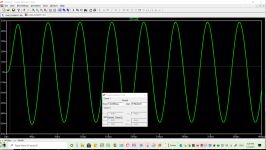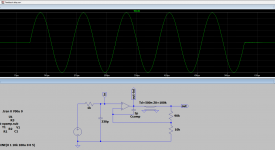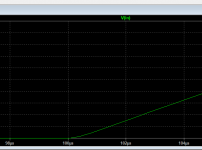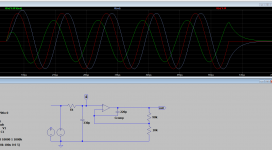There have been too many examples on usage of unmeasurable quantities used to promote snake oil products. Nobody can afford to put his vigilance to rest.
Petrov tried to show that the simulator analyzes the first period captured in the time window, so he manually glued several first periods in a row. In fact, only the first period is distorted there, and then the amplifier goes to the mode and visually nothing is noticeable.
Such a signal, as Petrov drew, can be obtained if there is a function gap between each period. But in this case, he was just trying to express his idea, which he did badly, I must admit.
Still, as we all tried to explain to him, it is a signal that does not exist in the physical universe. I wish he would actually read something from others.
This is a realistic signal from a starting sine wave. I understand it does not support his point, but really, that is because his point is wrong.
Jan
Attachments
Odd isn't it? He does appear very "focused" 😉I wish he would actually read something from others.
I guess it's working with finite starting sine waves as well. (If the delay is quite high.)
Or am I doing something wrong in my simulation?
Input filter = 1k + 330p.
Signal = 10kHz sine
Aol = 1k
PD = 500n
Or am I doing something wrong in my simulation?
Input filter = 1k + 330p.
Signal = 10kHz sine
Aol = 1k
PD = 500n
Attachments
I totally agree, Jan. In my post 878 First cycle distortion - Graham, what is that?, I also showed the same thing. And TNT hints at the same thing to Petrov - that transient distortion is only present at the start, as long as the amplifier does not have a well-defined output signal. And then everything falls into place. The problem is that Petrov thinks it happens all the time, with every change in amplitude or frequency. Therefore, he persistently tries to apply some clever modulations as a stimulus signal.Still, as we all tried to explain to him, it is a signal that does not exist in the physical universe. I wish he would actually read something from others.
This is a realistic signal from a starting sine wave. I understand it does not support his point, but really, that is because his point is wrong.
When Petrov used piecewise approximated signals as stimuli, there were constantly transient distortions at the points of discontinuities of the function. I think it confused him and made him believe that this was the case. I tried to explain his mistake to him, but it was taken emotionally, as if it was a personal attack. As a result, he did not critically comprehend my words and continued to counteract. He does the same thing now, because it is difficult to admit that he is wrong.
Still, as we all tried to explain to him, it is a signal that does not exist in the physical universe.
Neither do infinitely long sine waves exist in the physical universe.
So what? Engineers use both concepts, the unit step function and or infinite duration sine waves, for everyday engineering calculations. The engineer just needs to understand the limitations of the models chosen for use.
Does Petrov understand the limitations? Doesn't look very good from here.
But, it doesn't help convince him you are right if you are making the same type of mistake only with a different model.
Throw out the delay line and simply increase the compensation capacity to make the effect more obvious. In the example you gave, the system has a small phase margin, judging by the vibrations on the square wave shelf. And in addition, to sharpen the effect, you should exclude the input filter.I guess it's working with finite starting sine waves as well. (If the delay is quite high.)
Or am I doing something wrong in my simulation?
In addition, the graph of the voltage at the inverting input of the operational amplifier will be indicative. There will be a starting spike and then the difference signal will become sinusoidal when the system returns to normal (if it is stable).
Cortez, slew rate and group delay are speed parameters, they are related
You dont know what slew rate is either. Its when the amp is over.. F it im not wasting anymore time on a fence post.
Last edited:
Neither do infinitely long sine waves exist in the physical universe.
So what? Engineers use both concepts, the unit step function and or infinite duration sine waves, for everyday engineering calculations. The engineer just needs to understand the limitations of the models chosen for use.
Does Petrov understand the limitations? Doesn't look very good from here.
But, it doesn't help convince him you are right if you are making the same type of mistake only with a different model.
What mistake? Using a concept that doesnt exist in reality, like a square wave or a sine that starts instantly is one thing, constantly saying they do exist in reality is another. Even LTspice wont simulate a square wave, you have to give it a rise time.
Last edited:
There have been too many examples on usage of unmeasurable quantities used to promote snake oil products. Nobody can afford to put his vigilance to rest.
So... a proponent of academic freedom up to a point? ... to save the ignorant masses from thinking for themselves and being duped? ... as the purveyor of all knowledge and absolute truth in support of divine goodness and in absence of all evil?... (choir singing joy to the world) OK then
Yes, so you can see the exit to the mode. The amplifier has become slower and the effect is more pronounced. However, in the middle of the graph, we can see that the sine is normal. The differential input voltage has returned to normal and the output signal corresponds to the input with some definite accuracy.You mean like this? I'm not sure that's what we wanted... 🙄
(I wanted to show the effect with a 500ns delay value that's why I used the tline.)
Now you can look at the signal at the point of the inverting input, it will be eloquent. You can also plot Vout - Vin*10-this is the input-output delta on the same scale. Ideally, it will be a sine after entering the operating mode.
Neither do infinitely long sine waves exist in the physical universe. ...
I think you had problem hitting Submit this one, but after watching your text for a few seconds... - eeh, what the hey...
//
So... a proponent of academic freedom up to a point? ... to save the ignorant masses from thinking for themselves and being duped? ... as the purveyor of all knowledge and absolute truth in support of divine goodness and in absence of all evil?... (choir singing joy to the world) OK then
Like a proponent for anything, theres a point.
Better than a proponent for fake science. Do you understand the topic or do you just want to argue against science?
Here are the results.Now you can look at the signal at the point of the inverting input, it will
be eloquent. You can also plot Vout - Vin*10-this is the input-output delta on the same scale.
Ideally, it will be a sine after entering the operating mode.
The signal at the inverting input is the same as at the non-inverting input.
Attachments
Even LTspice wont simulate a square wave, you have to give it a rise time.
Maybe you never studied engineering math, specifically applications of the Laplace transform for electrical engineering calculations. The unit step function is an often used model since it can easily be transformed between the time domain and the complex frequency domain. In other words, concepts like step and or impulse models are used because of their mathematical convenience and their practical utility, not because they exist in physical reality.
Same thing for infinite duration sine waves when it comes to not existing in physical reality. Like I tried to explain before, we don't use idealized models because ideal devices, etc., exist in reality. We use them because they are very useful tools.
Regarding LT Spice, it obviously doesn't use Laplace transform engineering models or a step function would be supported.
EDIT: LT Spice does use other idealized models of components that don't exist in physical reality. Ideal controlled sources, etc. Those things don't seem to bother you.
Last edited:
I don't understand why you used a multiplier of 6.28 ? You have an amplifier with a factor of 10 and you need to bring the signals to the same scale to see the difference. Now they are on different scales and the result is incorrect.Here are the results.
The signal at the inverting input is the same as at the non-inverting input.
The problem is you never studied engineering math, specifically applications of the Laplace transform for electrical engineering calculations. The unit step function is an often used model since it can easily be transformed between the time domain and the complex frequency domain. In other words, concepts like step and or impulse models are used because of their mathematical convenience and their practical utility, not because they exist in physical reality.
Same thing for infinite duration sine waves when it comes to not existing in physical reality.
Regarding LT Spice, it obviously doesn't use Laplace transform engineering models or a step function would be supported.
The problem is you have no idea what your talking about, again. Did you even read what I said? I haven an EE degree with a few post grad courses and probably know the math better than you do. I wont repeat what I said, if you didnt get it the first time, theres no point.
You said LT Spice does not support a step function with infinite rise time. Petrov is using, what, Microcap? How does it deal with steps? Why would it let him use a step (or an abruptly starting sine) if it is illegal in its calculation engine?
EDIT: The problem I am having is that the arguments trying to get Petrov to change his thinking are getting silly. It has been argued that steps don't exist in reality, but nobody seems to mind that same is true for infinite duration sine waves. It has been argued that a simulator program that Petrov is not using does not support the calculation he is doing.
I understand that nothing else has worked to change Petrov's views yet, but those arguments don't seem sensible to me.
EDIT: The problem I am having is that the arguments trying to get Petrov to change his thinking are getting silly. It has been argued that steps don't exist in reality, but nobody seems to mind that same is true for infinite duration sine waves. It has been argued that a simulator program that Petrov is not using does not support the calculation he is doing.
I understand that nothing else has worked to change Petrov's views yet, but those arguments don't seem sensible to me.
Last edited:
- Home
- Amplifiers
- Solid State
- First cycle distortion - Graham, what is that?







